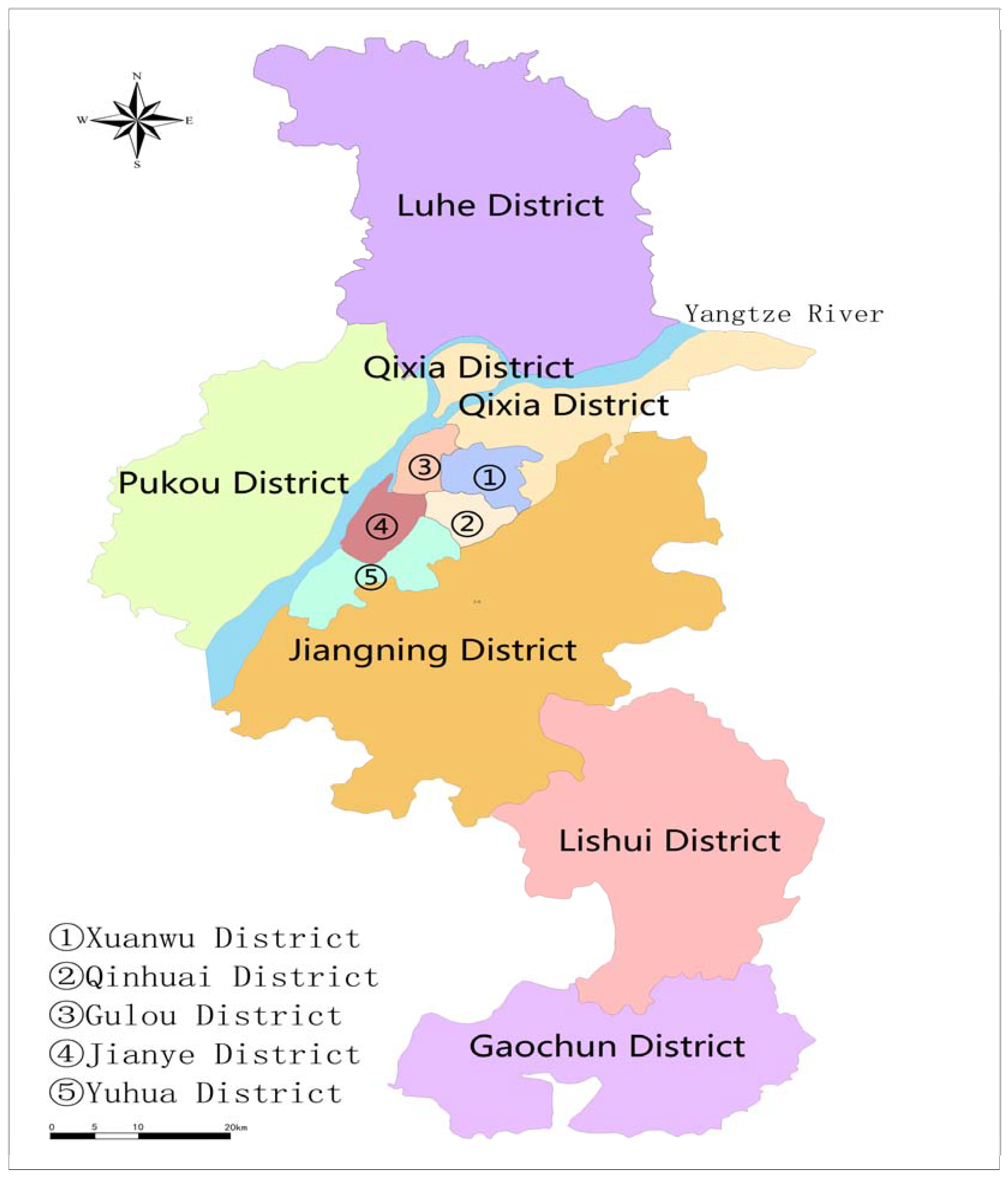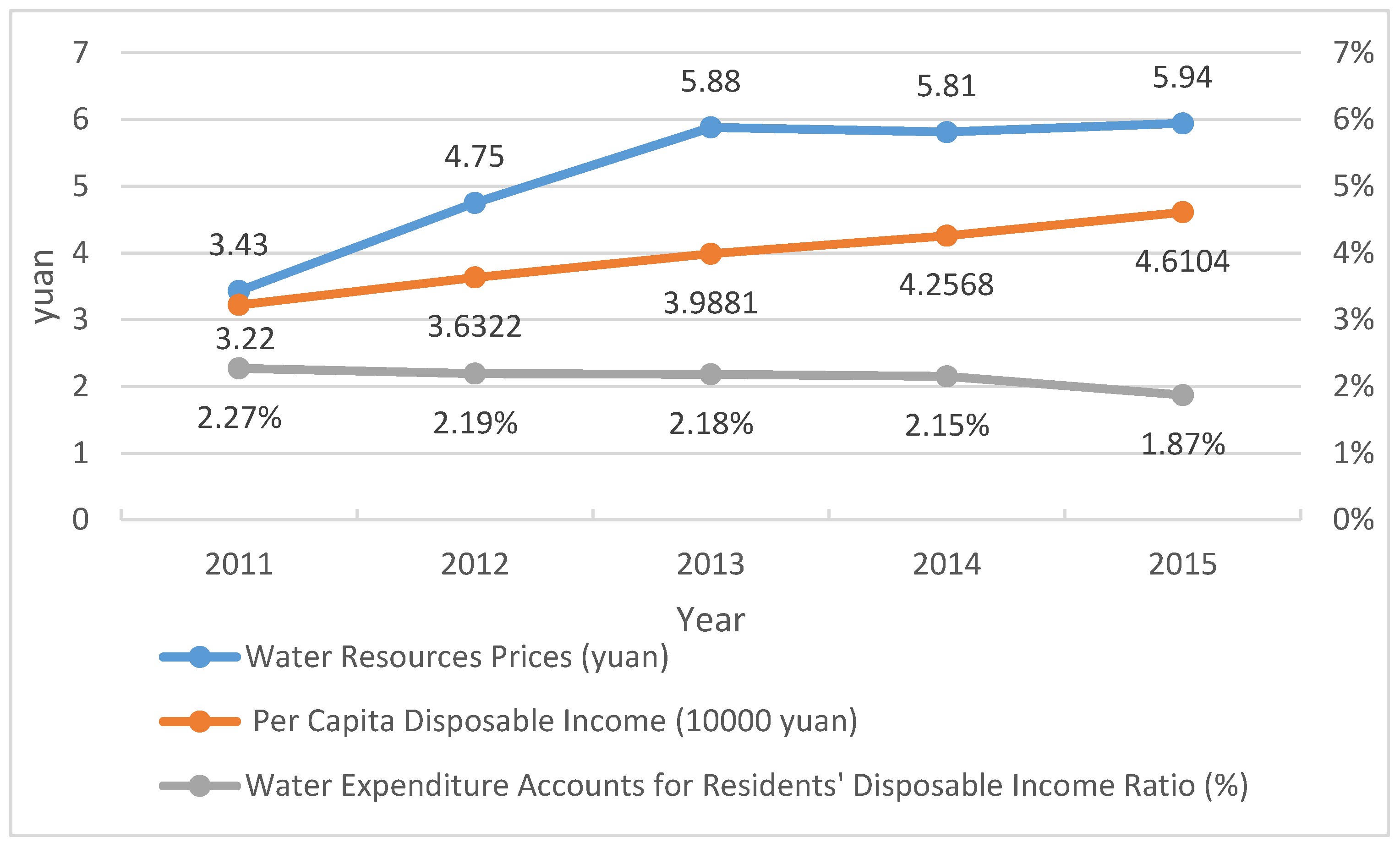Calculation of Water Resource Value in Nanjing Based on a Fuzzy Mathematical Model
Abstract
:1. Introduction
2. Materials and Methods
2.1. Research Area
2.2. Data Source
2.3. Methods
2.3.1. Fuzzy Comprehensive Evaluation Model of Water Resource Value
2.3.2. Entropy Method
2.3.3. Water Resource Price Calculation Model
3. Results and Discussion
3.1. Evaluation Index and Actual Value
3.2. Evaluation Criteria and Weights
3.3. Fuzzy Comprehensive Evaluation of Water Resource Value
3.4. Calculation of Water Resource Value
4. Summary and Conclusions
Author Contributions
Funding
Conflicts of Interest
References
- Gan, H.; Qin, C.; Wang, L.; Zhang, X. Study on water pricing method and practice I. Discussion on the connotation of water resources value. J. Hydraul. Eng. 2012, 43, 289–295. (In Chinese) [Google Scholar]
- Madhoo, Y.N. Political economy of water pricing policy: Empirical evidence from public utilities in Mauritius. Water Resour. Res. 2004, 40, 1–9. [Google Scholar] [CrossRef]
- Hung, M.F.; Chie, B.T. Residential water use: Efficiency, affordability, and price elasticity. Water Resour. Manag. 2013, 27, 275–291. [Google Scholar] [CrossRef]
- Molinos-Senante, M.; Mocholí-Arce, M.; Sala-Garrido, R. Estimating the environmental and resource costs of leakage in water distribution systems: a shadow price approach. Sci. Total Environ. 2016, 568, 180–188. [Google Scholar] [CrossRef] [PubMed]
- Sun, L.; Lu, W.; Yang, Q.; Martín, J.D.; Li, D. Ecological compensation estimation of soil and water conservation based on cost-benefit analysis. Water Resour. Manag. 2013, 27, 2709–2727. [Google Scholar] [CrossRef]
- Qian, L.; Wang, H.; Zhang, K. Evaluation criteria and model for risk between water supply and water demand and its application in Beijing. Water Resour. Manag. 2014, 28, 4433–4447. [Google Scholar] [CrossRef]
- Jian, F.; Song, X.; Yu, W.B. Construction of the evaluation system of water asset price with fuzzy comprehensive assessment indexes: Taking Zhangye Prefecture in Heihe River basin as an example. J. Glaciol. Geocryol. 2016, 38, 567–572. (In Chinese) [Google Scholar]
- Zhang, G.; Liu, H. Calculation of protective price in water trading for valley cities. Resour. Sci. 2010, 32, 372–379. (In Chinese) [Google Scholar]
- Deng, Y.; Bonilla, M.; Ren, H.; Zhang, Y. Health risk assessment of reclaimed wastewater: A case study of a conventional water reclamation plant in Nanjing, China. Environ. Int. 2017, 112, 235–242. [Google Scholar] [CrossRef] [PubMed]
- Nanjing Water Authority. Nanjing City Water Resources Bulletin; Nanjing Water Authority: Nanjing, China, 2015. Available online: http://shuiwu.nanjing.gov.cn (accessed on 11 July 2018).
- Cooper, B.; Crase, L.; Pawsey, N. Best practice pricing principles and the politics of water pricing. Agric. Water Manag. 2014, 145, 92–97. [Google Scholar] [CrossRef]
- Van Dijk, D.; Siber, R.; Brouwer, R.; Logar, I.; Sanadgol, D. Valuing water resources in Switzerland using a hedonic price model. Water Resour. Res. 2016, 52, 3510–3526. [Google Scholar] [CrossRef]
- Ioris, A.A.R. The value of water values: Departing from geography towards an interdisciplinary synthesis. Geogr. Ann. Ser. B Hum. Geogr. 2013, 95, 323–337. [Google Scholar] [CrossRef]
- Donoso, G. Urban water pricing in Chile: Cost recovery, affordability, and water conservation. WIREs Water 2017, 4, e1194. [Google Scholar] [CrossRef]
- Dai, M.; Wang, L.; Wei, X. Spatial difference of water resource carrying capacity of Guangxi using fussy comprehensive evaluation model based on entropy weight method. Res. Soil Water Conserv. 2016, 23, 193–199. (In Chinese) [Google Scholar]
- Molinos-Senante, M.; Donoso, G. Water scarcity and affordability in urban water pricing: A case study of Chile. Util. Policy 2016, 43, 107–116. [Google Scholar] [CrossRef]
- Chica-Olmo, J.; Gonzalez-Gomez, F.; Guardiola, J. Do neighbouring municipalities matter in water pricing? Urban Water J. 2013, 10, 1–9. [Google Scholar] [CrossRef]
- Garcia-Valinas, M.A.; Martinez-Espineira, R.; Gonzalez-Gomez, F. Affordability of residential water tariffs: Alternative measurement and explanatory factors in southern Spain. J. Environ. Manag. 2010, 91, 2696–2706. [Google Scholar] [CrossRef] [PubMed]


| Evaluating Index | Unit | Definition | Actual Number | |||||
|---|---|---|---|---|---|---|---|---|
| 2015 | 2014 | 2013 | 2012 | 2011 | ||||
| Water Resources Quantity | Total Water Resources | 106 m3 | Characterize regional water resources abundance | 4615 | 3076 | 2372 | 2699 | 3602 |
| Annual Precipitation | mm | Characterize the natural recharge ability of regional water resources | 1443.3 | 1243.7 | 947.9 | 1071.6 | 1087.4 | |
| Transit Water Resources | 109 m3 | Characterize the potential availability of water resources | 920.6 | 898.6 | 791.4 | 1007.9 | 671.5 | |
| Water Consumption Per Unit Area | 103 m3/km2 | Characterize the regional abundance of water resources | 700.6 | 467 | 360.1 | 409.7 | 546.8 | |
| Per Capita Water Resources | m3 | Characterize the status of water resources per capita | 560.35 | 374.38 | 289.7 | 330.72 | 444.2 | |
| Water Resources Quality | Reservoir and Lake Water Quality Compliance Rate | % | Characterize the status of reservoir and lake water quality | 96.8 | 93.5 | 96.7 | 93.3 | 94 |
| Water Function Area Water Quality Compliance Rate | % | Characterize the status of water function area water quality | 58.4 | 68.1 | 62.5 | 53.6 | 44.6 | |
| River Water Quality Compliance Rate | % | Characterize the status of river water quality | 46.7 | 44.1 | 40.2 | 34.4 | 28.1 | |
| Socioeconomic | Per Capita GDP | 103 yuan | Characterize the degree of regional economic development | 118.2 | 107.5 | 98 | 88.5 | 76.7 |
| Unit GDP Water Demand | m3 | Characterize the level of water used for economic development | 41.4 | 47.9 | 52.6 | 60.1 | 76 | |
| Industrial Water Consumption | 106 m3 | Characterize the degree of water used in industrial development | 1091 | 1514 | 1426 | 1368 | 1455 | |
| Residents Living Water Consumption | 106 m3 | Characterize the level of water used in social life | 856 | 920 | 864 | 915 | 1062 | |
| Farmland Irrigation Water Consumption | 106 m3 | Characterize the extent of water use in agricultural development | 1458 | 1272 | 1437 | 1532 | 1861 | |
| Evaluating Index | Unit | Character | Evaluation Standard | Index Weight | |||||
|---|---|---|---|---|---|---|---|---|---|
| High | Relatively High | Common | Relatively Low | Low | |||||
| Water Resources Quantity | Total Water Resources | 106 m3 | - | 3000 | 4000 | 5000 | 6000 | 7000 | 0.0794 |
| Annual Precipitation | mm | - | 500 | 800 | 1100 | 1400 | 1700 | 0.0766 | |
| Transit Water Resources | 106 m3 | - | 200 | 400 | 600 | 800 | 1000 | 0.0710 | |
| Water Consumption Per Unit Area | 103 m3/km2 | - | 400 | 600 | 800 | 1000 | 1200 | 0.0794 | |
| Per Capita Water Resources | m3 | - | 400 | 800 | 1200 | 1600 | 2000 | 0.0791 | |
| Water Resources Quality | Reservoir and Lake Water Quality Compliance Rate | % | + | 100 | 80 | 60 | 40 | 20 | 0.0880 |
| Water Function Area Water Quality Compliance Rate | % | + | 100 | 80 | 60 | 40 | 20 | 0.0709 | |
| River Water Quality Compliance Rate | % | + | 100 | 80 | 60 | 40 | 20 | 0.0715 | |
| Socioeconomic | Per Capita GDP | 103 yuan | + | 140 | 110 | 80 | 50 | 20 | 0.0729 |
| Unit GDP Water Demand | m3 | + | 60 | 50 | 40 | 30 | 20 | 0.0777 | |
| Industrial Water Consumption | 106 m3 | + | 2500 | 2000 | 1500 | 1000 | 500 | 0.0683 | |
| Residents Living Water Consumption | 106 m3 | + | 1200 | 1000 | 800 | 600 | 400 | 0.0893 | |
| Farmland Irrigation Water Consumption | 106 m3 | + | 2500 | 2000 | 1500 | 1000 | 500 | 0.0759 | |
| Factor | Unit | 2011 | 2012 | 2013 | 2014 | 2015 |
|---|---|---|---|---|---|---|
| Residential Water Price | yuan/m3 | 2.8 | 3.1 | 3.1 | 3.1 | 3.1 |
| Residents' per capita Disposable Income | yuan | 32,200 | 36,322 | 39,881 | 42,568 | 46,104 |
| Per Capita Water Consumption | m3 | 130.94 | 112.1 | 105.55 | 111.95 | 103.89 |
| Index of Water Rate Affordability | % | 3% | 3% | 3% | 3% | 3% |
| Water Supply Costs and Profits | yuan/m3 | 0.6 | 0.68 | 0.68 | 0.68 | 0.68 |
| Sewage Treatment Fees | yuan/m3 | 1.3 | 1.42 | 1.42 | 1.42 | 1.42 |
| Taxes Fees | yuan/m3 | 0.26 | 0.26 | 0.26 | 0.26 | 0.26 |
| Water Resource Price | yuan/m3 | 3.43 | 4.75 | 5.88 | 5.81 | 5.94 |
© 2018 by the authors. Licensee MDPI, Basel, Switzerland. This article is an open access article distributed under the terms and conditions of the Creative Commons Attribution (CC BY) license (http://creativecommons.org/licenses/by/4.0/).
Share and Cite
Jia, Y.; Shen, J.; Wang, H. Calculation of Water Resource Value in Nanjing Based on a Fuzzy Mathematical Model. Water 2018, 10, 920. https://doi.org/10.3390/w10070920
Jia Y, Shen J, Wang H. Calculation of Water Resource Value in Nanjing Based on a Fuzzy Mathematical Model. Water. 2018; 10(7):920. https://doi.org/10.3390/w10070920
Chicago/Turabian StyleJia, Yizhen, Juqin Shen, and Han Wang. 2018. "Calculation of Water Resource Value in Nanjing Based on a Fuzzy Mathematical Model" Water 10, no. 7: 920. https://doi.org/10.3390/w10070920





